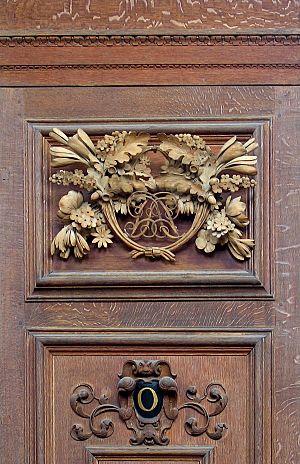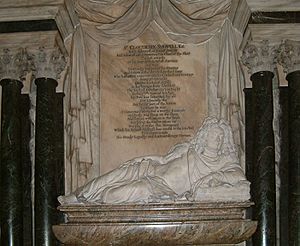Grinling Gibbons facts for kids
Quick facts for kids
Grinling Gibbons
|
|
|---|---|

Grinling Gibbons by Sir Godfrey Kneller
|
|
| Born | 4 April 1648 |
| Died | 3 August 1721 (aged 73) |
| Resting place | St Paul's, Covent Garden, London |
| Occupation | Famous Sculptor and Wood Carver |
| Known for | Works on St Paul's Cathedral |
Grinling Gibbons (born April 4, 1648 – died August 3, 1721) was a famous sculptor and wood carver. He was born in Holland to English parents. Gibbons is known for his amazing work in England.
He created beautiful carvings for many important places. These include Windsor Castle, Hampton Court Palace, and St Paul's Cathedral. He also worked on other London churches and grand country homes. Gibbons is considered the best wood carver in England from his time. Most of his carvings are made from lime wood. He often created detailed Baroque garlands. These were like decorative wreaths with flowers, fruits, and other natural items. They were used to decorate walls, mirrors, and churches. He also made furniture and small carved pictures. Besides wood, he also carved in stone for churches. Gibbons had a large workshop with many helpers.
Life of a Master Carver

We don't know much about Grinling Gibbons' early life. He was born in Rotterdam, Netherlands. Some people think his father was Samuel Gibbons, who worked with a famous architect named Inigo Jones.
Around 1667, Gibbons moved to Deptford, England. By 1680, he was already known as the "King's Carver." He received important jobs from the royal family. His carvings were so detailed and delicate. People said that a pot of carved flowers above his London house would shake from passing coaches.
A writer named John Evelyn discovered Gibbons' talent by chance in 1671. Gibbons rented a small house near Evelyn's home. Evelyn saw Gibbons carving by candlelight. He was working on a carved picture of a famous painting. Evelyn was very impressed. He then told Sir Christopher Wren, a famous architect, about Gibbons. Wren and Evelyn introduced Gibbons to King Charles II. The King gave Gibbons his first big job. This carving is still in the dining room of Windsor Castle.
Gibbons was part of the Drapers' Company in London. This was a guild, or a group of skilled workers. He was a respected member of this group.
Later, a writer named Horace Walpole wrote about Gibbons. He said that Gibbons made wood look light and airy like flowers. He could connect different natural things in a free and natural way. Grinling Gibbons is buried at St Paul's, Covent Garden in London.
Amazing Works of Art
Sir Christopher Wren hired Gibbons to work on St Paul's Cathedral. Later, King George I made him the master carver. King William III also asked Gibbons to create carvings. Some of these beautiful pieces are still at Kensington Palace today. For example, you can see his work above the fireplace in the Presence Chamber. This carving was meant to frame a portrait of Queen Mary II.
Many of Gibbons' amazing carvings can be seen in churches around London. You can find them in the choir stalls and organ case of St Paul's Cathedral. Some of his best work is at Petworth House in West Sussex. The Carved Room at Petworth has a large and detailed collection of his wooden carvings.
His work is also in London churches like St Michael Paternoster Royal and St James's Church, Piccadilly. In these churches, he carved the wooden screens behind the altar and marble fonts. These carvings often filled large spaces on the church walls.
In 1682, King Charles II asked Gibbons to carve a special panel. This was a gift for his friend, Cosimo III, the Grand Duke of Tuscany. This panel showed art winning over hate. It included a small carved picture of Cosimo's favorite painter. Today, this panel is in the Pitti Palace in Florence, Italy.
In 1685, King James II asked Gibbons to carve another panel. This one was for the Duke of Modena, Francesco II. This panel was a reminder of King Charles II, who had died earlier that year. It included a sad poem about death. This panel also has a small carved picture of Gibbons himself. It is now in the Estense Gallery in Modena, Italy.
The church of St Peter and St Paul in Exton, Rutland, has a beautiful marble tomb by Gibbons. It was made in 1685. It shows Viscount Campden with his wife and carvings of his 19 children.
Many skilled sculptors from Flanders (a region in Europe) worked in Gibbons' workshop. These included Arnold Quellin and Laurens van der Meulen. They helped Gibbons with his many projects. For example, Laurens van der Meulen and Peter van Dievoet worked together on the statue of King James II.
Gibbons also made a monument for Admiral Sir Cloudesley Shovell. The Admiral died in a terrible shipwreck in 1707. Shovell's large marble monument is in Westminster Abbey.
Legacy
Grinling Gibbons' connection to Deptford is remembered today. Grinling Gibbons Primary School is in Clyde Street, near where he used to live.
List of Works
- Memorial to William Windham, St. Margaret's Church, Felbrigg, Norfolk
See also
 In Spanish: Grinling Gibbons para niños
In Spanish: Grinling Gibbons para niños




